Next Lesson - Joints
Abstract
- Bones can be classified based on shape as either: Long, Flat, Short, Irregular or Sesamoid.
- They can have Supportive, Protective, Movement-related, Mineral and Growth Factor Storage-related and Haematopoietic (generation of blood cells) roles within the body.
- The key bones of the body are:
- The vertebrae (of the spine)
- The innominate/hip bone (forms the hip joint and is split into the ilium, ischium and pubis)
- The femur/tibia/fibula/patella bones (of the leg)
- The tarsals/metatarsals/phalanges (of the foot)
- The clavicle/scapula/humerus (of the shoulder)
- The humerus/radius/ulna (of the arm)
- The carpals/metacarpals/phalanges (of the hand).
Core
Bones make up the skeleton, providing a rigid framework that supports the body.
 Image: The human skeleton from a posterior (behind) view. The main bones of the human skeleton are labelled
Image: The human skeleton from a posterior (behind) view. The main bones of the human skeleton are labelled
Public Domain Source LadyofHats Mariana Ruiz Villarreal [Public domain]
The adult human skeleton comprises 206 bones, each with individual roles within the body. 5 key roles of bones are:
- Support
- Protection
- Movement
- Mineral and Growth factor storage
- Haematopoiesis (generation of blood cells, such as erythrocytes and lymphoid lineage cells, from haematopoietic stem cells in the bone marrow)
Bones are classified based on their shapes:
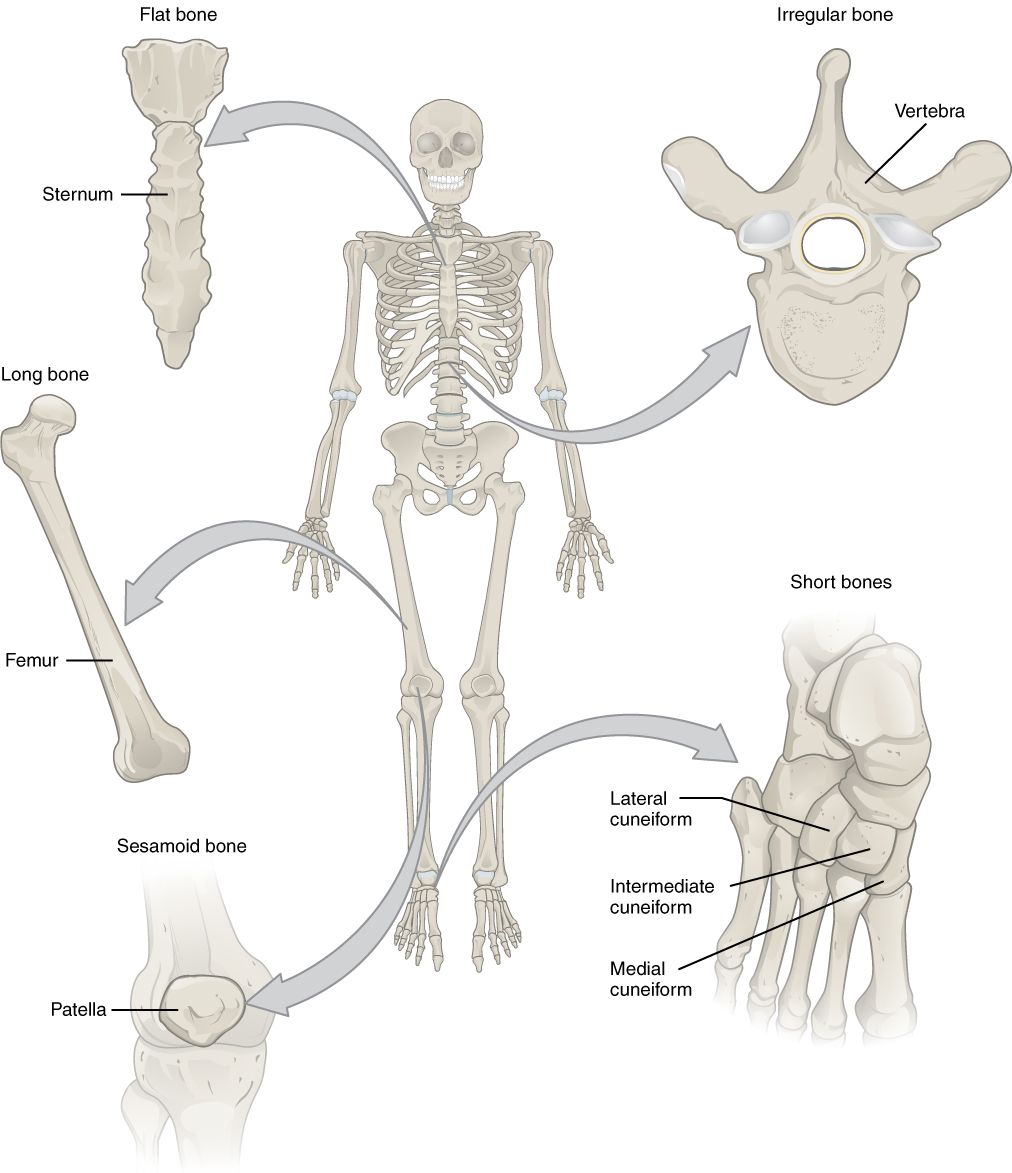
Image: The different classifications of shape of bone, the most important being the long, flat, short, irregular and sesamoid bones
Creative commons source by OpenStax College [CC BY 3.0 (https://creativecommons.org/licenses/by/3.0)]
- Long (eg. Femur and Humerus) - longer than they are wide and key for locomotion. Common features include a shaft and articulations at both ends.
- Flat – generally used for protection or muscle attachment (eg. The skull, the thoracic cage (sternum and ribs), and the pelvis (ilium, ischium, and pubis)).
- Short – small bones which are roughly as wide as they are long found in some joints (eg. The carpal bones in the wrist and the tarsal bones in the ankles).
- Sesamoid – bones which sit within tendons or muscle and are used to transfer force (eg. Patella).
- Irregular – bones which do not occupy any of the other categories (eg. Vertebrae).
The key bones of the human body
Later lessons will cover each of these bones in further detail. This section is only a brief overview and introduction.
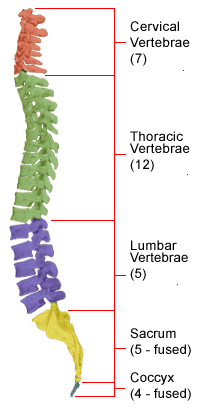 Image: The 5 vertebral regions of the spine, with the number of vertebrae in each region labelled
Image: The 5 vertebral regions of the spine, with the number of vertebrae in each region labelled
Modified Public Domain Image
The spine, known also as the vertebral column, extends from the skull to the coccyx. Almost a quarter of its length is made of intervertebral discs, with the remainder from the vertebrae and sacrum. In total there are 33 vertebrae including:
- 7 cervical vertebrae
- 12 thoracic vertebrae
- 5 lumbar vertebrae
- 5 sacral vertebrae
- 4 coccygeal vertebrae
Each vertebra is referenced according to its spinal region (cervical, thoracic, lumbar, sacral), followed by a number relating to its vertical position of the vertebral body along the spine
E.g. third lumbar vertebra caudally = L3.
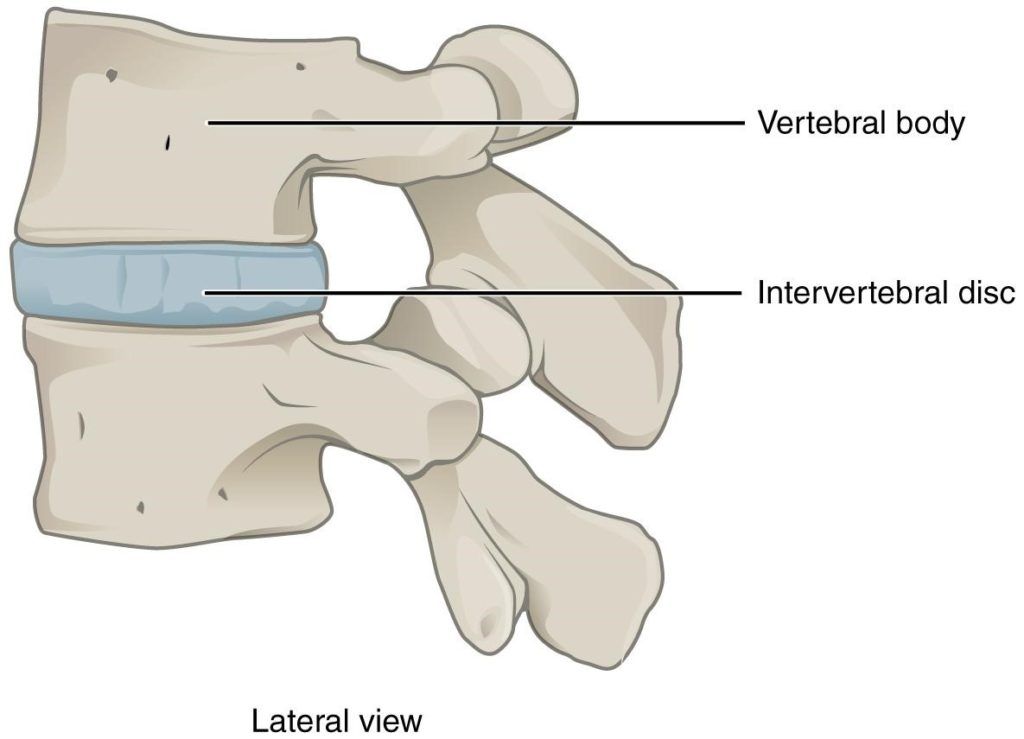
Image: A diagram of the location of an intervertebral disc between the vertebrae.
Creative Commons Image source by OpenStax College [CC BY 3.0 (https://creativecommons.org/licenses/by/3.0)]
Intervertebral discs are named relative to the vertebrae above and below that disc;
E.g. the disc between L2 and L3 is the L2/3 intervertebral disc.
The cervical, thoracic and lumbar vertebrae are composed of non-fused individual vertebrae capable of independent movement. Those in the cervical and lumbar spine are relatively mobile. Vertebrae in the thoracic spine on the other hand are less mobile due to being joined by the ribs to the sternum. The sacrum and coccyx are comprised of fused vertebrae.
Check out our article on The Spine for more information.
Image: A diagram showing the 3 parts of the innominate (hip) bone.
Modified Public Domain Image
The hip/innominate bone is a flat bone that forms the hip joint with the femur of the leg. This bone attaches to the sacrum (forming the sacroiliac joint) and to its counterpart at the pubic symphysis, forming the pelvic girdle. It is made up of three fused bones:
- Ilium
- Ischium
- Pubis
The innominate bone has a number of landmarks including:
- Acetabulum – the point of articulation with the head of the femur. It lies at the point where the 3 fused bones meet. Acetabulum in Latin translates as vinegar cup reflecting its cup shaped form.
- Anterior superior iliac spine – ASIS – a bony ridge on the anterior aspect of the ilium.
- Iliac crest – a bony ridge on the superior aspect of the ilium.
- Ischial tuberosity – a large knob of bone on the ischium which the body rests on whilst sitting. Colloquially known as the ‘sitting bones’.
Check out our article on conditions of the hip for more information.
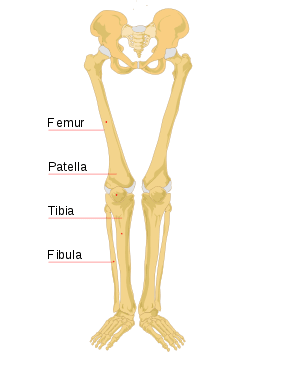
Image: A diagram showing the main bones of the leg and knee.
Public Domain Image by Jecowa at English Wikipedia
The lower limb (excluding the foot and ankle) is made up of four bones; the femur, tibia, fibula, and patella.
The femur has two articulations. The head of the femur articulates with the acetabulum in the hip/innominate bone, forming the hip joint. The femoral condyles at the distal aspect of the femur articulate with the tibia and patella forming the knee joint - note, the femur does not articulate with the fibula. The femur is the only bone in the thigh.
The patella is commonly referred to as the knee cap. Its’ primary function is to increase the force that the quadriceps tendon can exert on the femur by increasing the angle at which it acts. The patella also provides protection to the knee joint.
The tibia is also known as the shinbone and is the larger of the two bones in the leg. It articulates with the femur at the knee and the bones of ankle in the foot.
The fibula is located laterally to the tibia, with which it is connected at the top and bottom. Its upper extremity lies posterior to the head of the tibia, below the knee joint. Its lower extremity forms the lateral part of the ankle-joint.
Check out the bones of the lower limb in more detail here.
Also, check out the muscles of the thigh and muscles of the lower leg and the conditions associated with the thigh, knee and lower leg.
 Image: Diagram showing the bones of the foot.
Image: Diagram showing the bones of the foot.
Modified Public Domain Image
The bones of the foot are split into three categories, the:
- Tarsals (7): talus, calcaneus, cuneiforms (3), cuboid, and navicular
- Metatarsals (5): first, second, third, fourth, and fifth metatarsal bone
- Phalanges (14): arranged in 3 phalanxes, proximal, intermediate and distal.
The Tarsal bones can be remembered with the helpful mnemonic:
This (Talus)
Circus (Calcaneus)
Needs (Navicular)
Cooler (Cuneiforms)
Clowns (Cuboid)
Check out our article on the bones of the foot and conditions that can affect the foot for more information.
Bones of the Upper Limb
Bones of the Shoulder
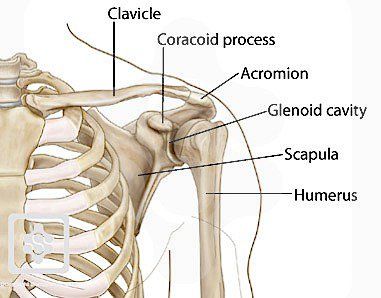
Image: Diagram showing the main bones and bony-landmarks of the shoulder joint.
The shoulder is made up of three bones: the clavicle (collarbone), the scapula (shoulder blade), and the humerus (upper arm bone).
The articulations between these bones make up the shoulder joints. The glenohumeral joint (articulation between the glenoid fossa of the scapula and the head of the humerus), is the major joint of the shoulder. The other joint of note in the shoulder is the acromioclavicular joint between the clavicle and the acromion which is a feature on the scapula.
Check out our articles on bones of the upper limb, muscles of the shoulder and conditions of the shoulder for more information.
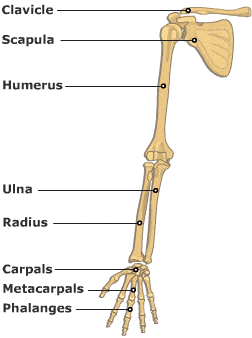
Image: Diagram showing the main bones of the arm.
The arms are composed of three bones; the humerus, the radius and the ulna.
The humerus articulates with the scapula at the shoulder joint. it also is attatched to the other long bones of the forearm, the ulna and radius at the elbow joint. The elbow is the hinge joint between the end of the humerus and the ends of the radius and ulna.
Check out our articles on bones of the upper limb, muscles of the upper arm, muscles of the forearm, conditions of the arm and conditions of the elbow.
 Image: diagram showing the main bone-groups making up the hand.
Image: diagram showing the main bone-groups making up the hand.
Public Domain Image
The bones of the hand are split into three categories, the:
- Carpals (8): Scaphoid, Lunate, Triquetrum, Pisiform, Trapezium, Trapezoid, Capitate, Hamate
- Metacarpals(5): first, second, third, fourth, and fifth metatarsal bone, starting from the thumb to the little finger
- Phalanges (14): arranged in 3 phalanxes, proximal, intermediate and distal.
A helpful (if NSFW) mnemonic to remember the carpal bones of the hand is:
Some (Scaphoid)
Lovers (Lunate)
Try (Triquetrum)
Positions (Pisiform)
That (Trapezium)
They (Trapezoid)
Cannot (Capitate)
Handle (Hamate)
This mnemonic describes the position of the carpal bones from lateral to medial naming the proximal row first and distal row second.
Check out our articles on bones of the hand and conditions of the forearm and wrist and conditions of the hand.
To understand bones, their role and their function, first we must understand their composition, precisely connective tissue, cartilage and the bone forming process. This can be found in the next lesson here.
Edited by: Dr. Ben Appleby
- 19610


